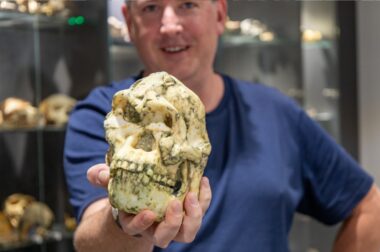The International Space Station? Emu in the Sky? Saturn’s rings? Supernova 1987a?
Embrace your dark side and vote in our national poll.
Media contacts: Shelley Thomas, [email protected] or 0416 377 444; or Tanya Ha, [email protected] or 0404 083 863.
Full media kit and images: www.scienceinpublic.com.au/science-week/abc-night-sky-poll
Participate at: www.abc.net.au/nightsky from 5 August.
Do you love gazing at the Milky Way? Are you intrigued by the Emu in the Sky and its significance for Indigenous culture? Have you witnessed technicolour displays of Aurora australis?
This National Science Week, ABC Science wants people to vote in a national poll that asks: ‘What’s the most amazing thing you’ve seen in the night sky?’.
Launched today, it focuses on 22 ‘amazing things’ – a comparatively miniscule number when our home galaxy, the Milky Way, contains more than 100 billion stars.
What will you vote for? Jupiter’s moons; comets; a meteor shower; planetary conjunction; a lunar eclipse; the International Space Station; or even the Starlink satellite ‘train’? Participants can also suggest anything missed off the list.
For dark sky defender, Marnie Ogg, a bigger question begs. What will you miss gazing at the most should it vanish from view?
The night sky, she says, is our window to the Universe. But light pollution is drawing the curtains on our ability to observe Earth’s cosmic neighbourhood, with negative knock-ons to our health and the survival of creatures and culture.
“Chances are, many people – particularly those living in cities and urban areas – don’t know about the amazing things they’re already missing,” says Marnie, who founded the Australasian Dark Sky Alliance, a non-profit dedicated to conserving the night sky and combatting light pollution.
Light pollution occurs when ‘sky glow’ from artificial lighting is so powerful that it literally out-glows the stars. Today, an estimated 80 per cent of the world’s population lives under sky glow, with 99 per cent of people in the US and Europe missing the experience of a dark night sky. Find out more.
The loss of Sky Country worries Peter Swanton, a Gamilaraay/Yuwaalaraay man and Indigenous Research Associate at the ANU Research School of Astronomy and Astrophysics.
“It disconnects Indigenous people from our stories, culture and Country,” he says.
Evolutionary and behavioural ecologist, Professor Therésa Jones, who leads University of Melbourne’s Urban Light Lab, says light pollution, although seemingly simple to solve, is a particularly challenging topic.
Her research shows Australia’s iconic black swans are struggling to sleep under the glare of blue-rich LED streetlights, which also play havoc with the mating behaviour of willie wagtails.
“Ironically, the very thing that makes us feel safe does the exact opposite for our native wildlife, reducing immune function and impacting circadian rhythms, survival, reproduction and growth across a range of species.”
The ABC dark sky project also invites you to:
- explore solutions to light pollution using an interactive;
- take part in an online ANU survey of the Milky Way’s visibility; and
- stargaze with ABC Radio National’s Night Sky LIVE (Thursday August 15, 8-9pm AEST, on RN and the ABC Listen app), when BIG IDEAS Presenter Natasha Mitchell broadcasts from the rooftop of ABC Melbourne.
ABC’s dark sky project is the online initiative for National Science Week 2024, undertaken by ABC Science with funding through the Australian Government’s Inspiring Australia strategy.
The first round of voting opens today, with a short-list to be revealed on Monday 12 August, followed by a second round of voting, and the winner announced on Friday 16 August. Vote here.
Media contacts: Shelley Thomas, [email protected] / 0416 377 444 or Tanya Ha [email protected] / 0408 083 863
Available for interviews:
- Marnie Ogg, founder of the Australasian Dark Sky Alliance
- Fred Watson AM, Australia’s Astronomer at Large.
- Therésa Jones, evolutionary and behavioural ecologist, University of Melbourne
- Peter Swanton, Gamilaraay/Yuwaalaraay man and cultural astronomer at ANU
- Brad Tucker, astrophysicist and cosmologist at Mt Stromlo Observatory, ANU
- Sheryn Pitman, project lead, Australia’s first International Dark Sky Community, Carrickalinga (South Australia)
- Carol Redford (aka Galaxy Girl), founder and CEO of Astrotourism WA
- Kylie Andrews, ABC Science journalist and National Science Week project lead
- Jacinta Bowler, ABC Science journalist.
What's the most amazing thing you've seen in the night sky? The long list:
- Aurora
- Comet
- Emu in the Sky
- The International Space Station
- Jupiter's moons
- Large and Small Magellanic Clouds
- Lightning sprites
- Lunar eclipse
- Mars
- Meteor or shooting star
- Meteor shower
- The Milky Way
- The Moon
- Moon halo
- Stargazing in a dark sky location
- Orion Nebula
- Planetary conjunction
- Pleiades
- Saturn's rings
- Starlink train
- Supernova 1987a
- Venus


